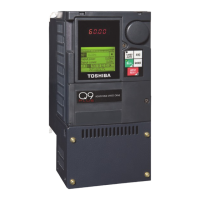146 https://www.toshiba.com/tic/
Direct Access Parameter Information
Q9 Plus ASD Install/Op Manual
PID Control Switching
Program Feedback Feedback Settings
This parameter is used to set the PID control mode.
Selecting Process PID uses the upper and lower-limit settings of
parameters F367 and F368.
Selecting Speed PID uses the upper and lower-limit settings of
parameters F370 and F371.
Settings:
0 — PID Off
1 — Process PID
2 — Speed PID
4 — Dancer Control
Direct Access Number —
F359
Parameter Type — Selection List
Factory Default — PID Off
Changeable During Run — No
PID Feedback Signal
Program Feedback Feedback Settings
This parameter Enables/Disables PID feedback control. When
enabled, this parameter determines the source of the motor con-
trol feedback.
Settings:
0 — Feedback Value = 0
1 — V/I
2 — RR
3 — RX
4 — RX2 (AI1 Option)
5 — Option V/I (AI2 Option)
6 — PG Feedback Option
Proportional-Integral-Derivative (PID) — A closed-loop control
technique that seeks error minimization by reacting to three val-
ues: one that is proportional to the error, one that is representa-
tive of the error, and one that is representative of the rate of
change of the error.
Direct Access Number —
F360
Parameter Type — Selection List
Factory Default — V/I
Changeable During Run — No
PID Feedback Delay Filter
Program Feedback Feedback Settings
This parameter determines the delay in the ASD output response
to the motor control feedback signal (signal source is selected at
F360).
Direct Access Number —
F361
Parameter Type — Numerical
Factory Default — 0.1
Changeable During Run — Yes
Minimum — 0.0
Maximum — 25.0
PID Feedback Proportional (P) Gain
Program Feedback Feedback Settings
This parameter determines the degree that the Proportional func-
tion affects the output signal. The larger the value entered here,
the quicker the ASD responds to changes in feedback.
Direct Access Number —
F362
Parameter Type — Numerical
Factory Default — 50.00
Changeable During Run — Yes
Minimum — 0.01
Maximum — 100.00
F359 – F363

